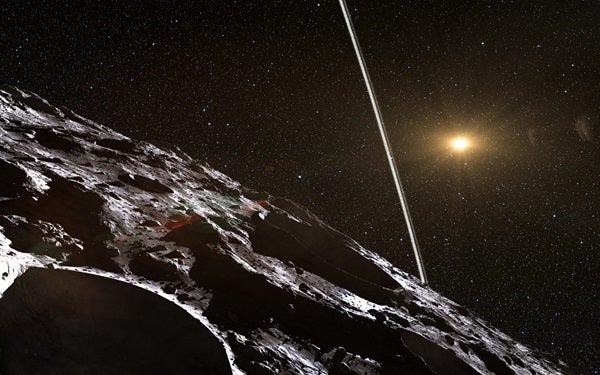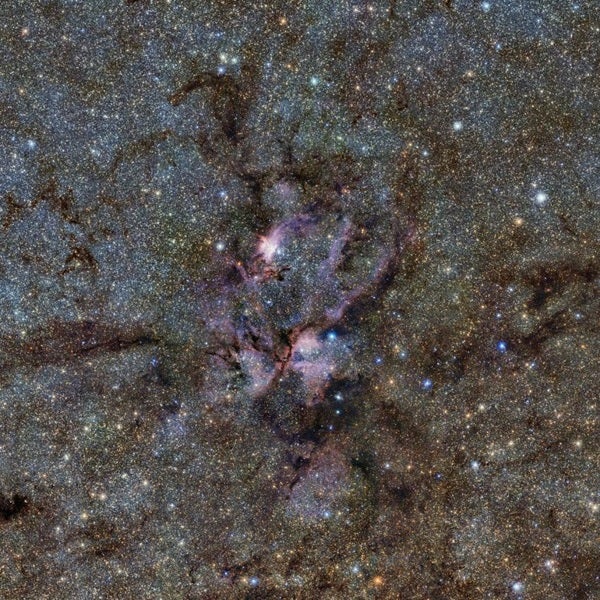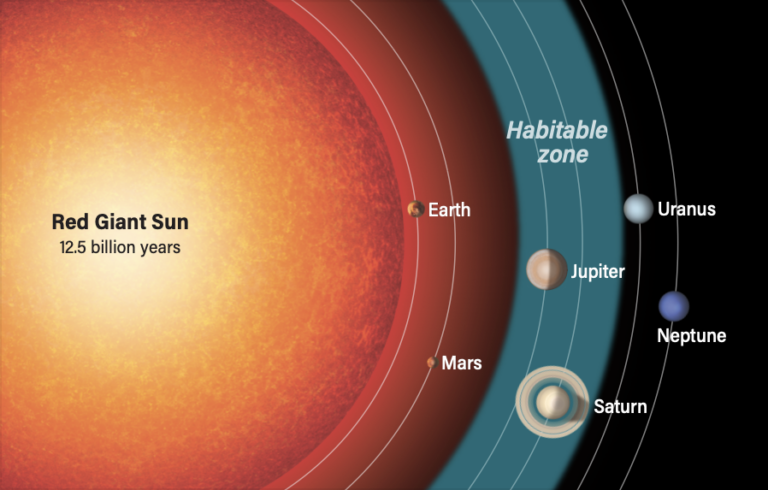Our solar system seems to be hiding a small group of alien objects that began their lives around another star before moving to our cosmic neighborhood. New research suggests that 19 Centaurs — icy asteroids with occasional cometlike behavior that usually orbit between Jupiter and Neptune — did not originate in our solar system. Instead, the researchers propose the icy rocks were stripped, individually or en masse, from a nearby star when the Sun was just a newborn in a larger stellar nursery.
“Astronomers have known for a long time that there should be asteroids circling the Sun that were not formed in the solar system, but instead were captured early on during the formation of the planets,” Fathi Namouni, an astronomer at the Observatoire de la Côte d’Azur in France, tells Astronomy. “The difficulty was that we could not tell which are solar system-born and which are extrasolar-born.”
Predicting the past
Rewinding the solar system’s 4.5-billion-year history is a challenge at best. Over such large timescales, small differences in our models can produce dramatically different results. This led Namouni and his colleagues to take a statistical approach. After preselecting a group of Centaurs, they made millions of virtual clones, then rewound the trajectories of those clones back in time.
They found the objects seem to have had polar orbits around the Sun, perpendicular to the plane of the solar system. These unusual orbits, the researchers say, indicate the objects initially came from another star. The new research was published April 23 in Monthly Notices of the Royal Astronomical Society.
“They’ve chosen a great problem,” says astronomer Kat Volk of the University of Arizona Department of Planetary Sciences. Although not involved with the new research, Volk uses simulations to study objects at the outer edges of the solar system. Regarding the apparent interstellar travelers, she says, “we don’t have a great explanation for how you would make these objects.”
Nearly 5 billion years ago, the Sun was part of a larger collection of baby stars born in cluster. Following the Sun’s formation, the leftover material nearby clumped together, forming a rotating disk that ultimately built the planets.
But the details of the how our solar system formed remain uncertain. The current idea is that the ice giants Uranus and Neptune traded places, pushing remaining icy debris farther away from the Sun. A fifth giant planet may also have orbited the Sun, eventually ejected by interactions with our solar siblings. And it’s possible that a yet-unseen planet, nicknamed Planet Nine, remains hidden somewhere in the outskirts of the solar system.
All of these problems have made it incredibly complicated to trace back the orbits of objects that emigrated from other stars. But Namouni and his colleagues soon realized that knowing how an object first orbited the Sun could help.
In 2018, Namouni and his colleagues revealed the likely interstellar origins of asteroid Ka’epaoka’awela, which roughly means “mischievous, opposite-moving companion of Jupiter” in Hawaiian. Initially spotted in 2014, Ka’epaoka’awela has an unusual, high-inclination orbit, meaning it ventures far above and below the plane of the solar system. And because of the challenge of retracing the path of an individual object, the researchers decided to try a new way of tackling the problem: They called in the clones.
“We found a way to beat [the chaos] — at a price,” Namouni said. “By cloning [an] asteroid’s orbit a million times, we can navigate what mathematicians call the chaotic sea and find the stability islands that the centaurs occupy.”
The tradeoff of this method is that you still can’t really track precisely where a given Centaur was 4.5 billion years ago. The researchers only know the statistical probability of where a given asteroid was at the beginning of our solar system.
The researchers used this method to reveal that Ka’epaoka’awela’s orbit — even 4.5 billion years ago — also dipped above and below our solar system’s disk of planet-forming material. And, as mentioned, such an off-kilter orbit suggests that the asteroid initially came from outside the solar system.
“One of the important consequences of that work was to point out that there should be more Centaurs on high-inclination orbits that did not belong to the solar system,” Namouni says. “So we set out to find them. And we did.”
Exposing alien Centaurs
Namouni and his colleagues targeted 19 high-inclination objects with their clone-rich simulation. And to their surprise, they found that the tilted orbits of all 19 objects could extend to the beginning of the solar system. In all, this shed doubt on a local origin for the Centaurs.
When the Sun was born, many of its stellar siblings began their lives at the same time. Since then, the stars have gone their separate ways. But if planetary formation happened while they were still living under the same cosmic roof, then material could have been traded between the nearby star systems.
But did they all swap material at the same time? Or was it more akin to getting hand-me-downs, where the trades came in separate bursts? In the future, the researchers hope to answer this question by determining whether the Centaurs came to our solar system as a group or trickled in, one by one.
Are these really interstellar objects?
The presence of extrasolar material in the solar system is not a surprise. “It is entirely possible that we do have populations of small bodies that do originate around other stars,” Volk says. But other studies indicate that much of that alien material likely hides in the Oort Cloud — a huge, nebulous sphere of icy material that encases our solar system, beginning a few thousand times farther from the Sun than Earth.
“It’s possible that the authors of the paper are correct,” Volk says. “I just don’t think that what they’ve done in the paper supports that conclusion.”

Want to learn more about pulsars and other extreme objects in our universe? Check out our free downloadable eBook: Exotic objects: Black holes pulsars, and more.
Volk’s chief concern is the extreme lifetime of the clone model. “I don’t buy that you can do that over billion-year timescales,” she says. While she thinks rewinding many clones might be an effective strategy over a few tens of millions of years, she doubts the inherent chaos would allow the models to function over 4.5 billion years.
“It’s just inherently very difficult to do these kinds of backwards integrations and have the results be representative,” Volk says.
Another major concern Volk has is that Namouni and his team omitted planetary migration from their calculations. “They are completely neglecting that, and I don’t agree with their arguments that that is not important,” she says.
Namouni says that the large polar orbits of these apparently alien objects means that the Centaurs spend very little time in the region where planetary migration could interfere. That includes the hypothetical Planet Nine, whose influence Volk was also concerned about. Namouni argues that the new method allows researchers to be agnostic about the early solar system conditions that remain uncertain.
“Our situation cannot be fine-tuned to change its outcome,” Namouni says. “It only has one outcome.”
That outcome, of course, is that the 19 Centaurs examined were all born around other stars.











